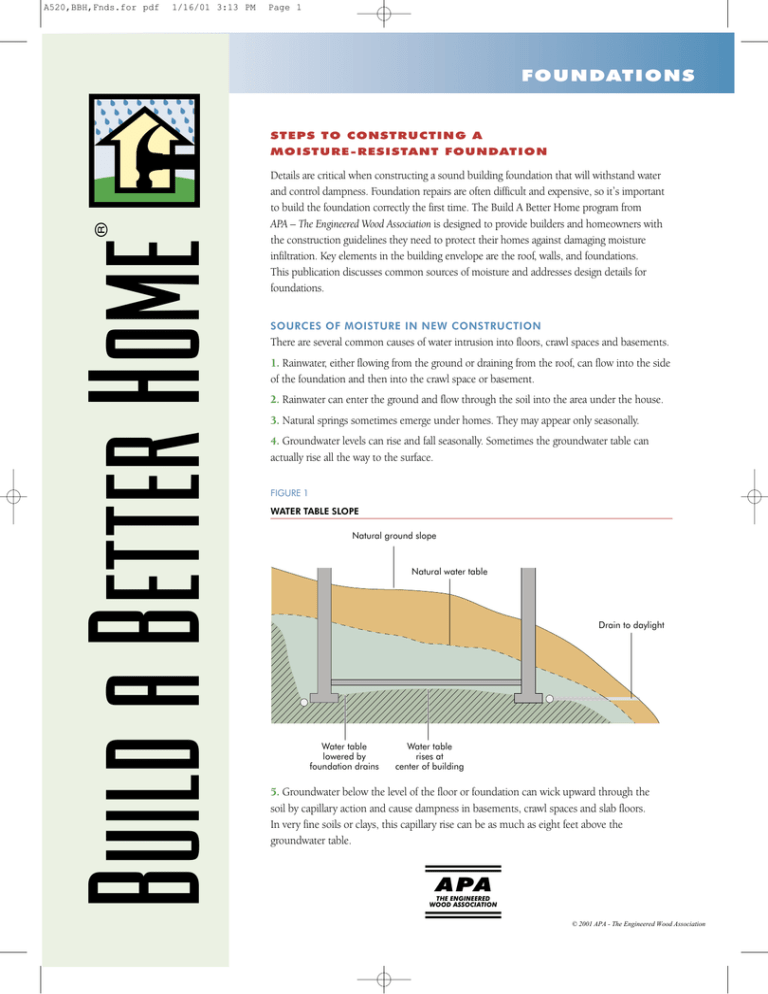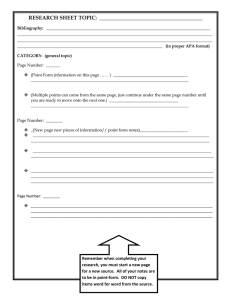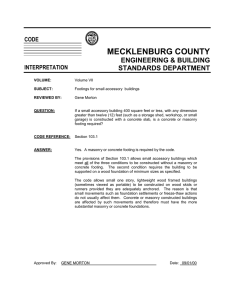
A520,BBH,Fnds.for pdf
1/16/01 3:13 PM
Page 1
FOUNDATIONS
STEPS TO CONSTRUCTING A
Build a Better Home
MOISTURE -RESISTANT FOUNDATION
Details are critical when constructing a sound building foundation that will withstand water
and control dampness. Foundation repairs are often difficult and expensive, so it’s important
to build the foundation correctly the first time. The Build A Better Home program from
APA – The Engineered Wood Association is designed to provide builders and homeowners with
the construction guidelines they need to protect their homes against damaging moisture
infiltration. Key elements in the building envelope are the roof, walls, and foundations.
This publication discusses common sources of moisture and addresses design details for
foundations.
SOURCES OF MOISTURE IN NEW CONSTRUCTION
There are several common causes of water intrusion into floors, crawl spaces and basements.
1. Rainwater, either flowing from the ground or draining from the roof, can flow into the side
of the foundation and then into the crawl space or basement.
2. Rainwater can enter the ground and flow through the soil into the area under the house.
3. Natural springs sometimes emerge under homes. They may appear only seasonally.
4. Groundwater levels can rise and fall seasonally. Sometimes the groundwater table can
actually rise all the way to the surface.
FIGURE 1
WATER TABLE SLOPE
Natural ground slope
Natural water table
Drain to daylight
Water table
lowered by
foundation drains
Water table
rises at
center of building
5. Groundwater below the level of the floor or foundation can wick upward through the
soil by capillary action and cause dampness in basements, crawl spaces and slab floors.
In very fine soils or clays, this capillary rise can be as much as eight feet above the
groundwater table.
A PA
THE ENGINEERED
WOOD ASSOCIATION
© 2001 APA - The Engineered Wood Association
©2001 APA – THE ENGINEERED WOOD ASSOCIATION • ALL RIGHTS RESERVED. • ANY COPYING, MODIFICATION, DISTRIBUTION OR OTHER USE OF THIS PUBLICATION OTHER THAN AS EXPRESSLY AUTHORIZED BY APA IS PROHIBITED BY THE U.S. COPYRIGHT LAWS.
A520,BBH,Fnds.for pdf
1/16/01 3:13 PM
Page 2
6. New concrete will usually be damp
to the touch for several weeks or even
months. This is because new concrete
contains excess water and the dampness
occurs as the water evaporates. This
type of dampness is not a long-term
problem.
7. During construction, landscaping,
remodeling or just over time, existing
footing drain (perimeter drain) systems
can become clogged with dirt or tree
roots, crushed, broken, or severed.
Subsequent water backup may cause
dampness or even flooding.
GENERAL CONSIDERATIONS
AND PREVENTIVE MEASURES
The following construction practices will
minimize water problems in many foundation installations. While common in
commercial construction, many of these
suggested practices are often omitted in
residential construction. In addition to
following these preventive steps, it’s a
good idea to consult an engineer to
insure the foundation is designed and
built correctly. In some cases, a geotechnical survey is also recommended.
Identify and Design
for Expansive Soils
These soils are clays that absorb moisture within each fine particle. In the
process, they expand with enough force
to crack or collapse all but the strongest
walls and floors. Cracks in a basement
wall provide a more direct path for water
intrusion in addition to increasing the
potential for structural damage.
Typically, expansive soils are removed
and replaced by a backfill material consisting of soils or gravels that do not
expand when wet. When building on
expansive soils, it is doubly important
that rain or groundwater does not get
under the footing or floor slab.
Install a Footing Drain
A footing drain (Figures 2, 3, 5, and 6)
is one of the most essential features and
is common to all types of foundations.
It should be installed around the
perimeter of the foundation and discharged to a suitable location downhill
from the home, into a drywell or into a
storm sewer system.
(Where soil, adjacent structures or
ground elevations prevent gravity
drainage, a sump must be installed and
the water pumped to a dry well, or
discharged downhill from the house. If
the water is pumped to a storm sewer, a
licensed plumber may be required to
install the connection to the sewer.)
Install a footing drain as follows:
1. Place a geotextile (filter) fabric on the
bottom of the excavation.
2. Cover with four inches of one-size,
clean, 3/4-inch crushed stone or gravel.
3. Place four-inch minimum diameter
perforated drainpipe over the gravel if
the soil is clay. Use a six-inch perforated
pipe if the soil is sandy and there is a lot
of water to redirect. Orient the perforations down. The drainpipe may be laid
level along the footing.
4. At the point where the footing drain
leaves the perimeter of the house, connect the perforated footing drain to an
unperforated drainpipe of the same
diameter and run to a downhill area,
away from the house, to a drywell,
storm sewer or to a suitable location for
an above-ground discharge.
5. Cover the perforated drainpipe with
about six inches of clean gravel and cover
the gravel with the geotextile fabric.
2
PREVENTIVE MEASURES
FOR SPECIFIC
FOUNDATION TYPES
Most homes are built on one of three
types of foundations: slab-on-grade,
crawl space, or full basement. Pressurepreservative-treated wood, masonry,
post-and-pier and pilings are occasionally used. Only concrete and masonry
(concrete block) foundations are
addressed in this publication, although
the principles of good practice are common to others.
Slab-on-Grade Foundation
Slab-on-grade foundations are simple to
build because the floor and footing can
be poured as one unit. The floor is
typically at, or only slightly above,
ground level. Walls of any height can
be formed on top of the slab-on grade
foundation system.
If fine soils or clays are present, and the
water table may rise to within ten feet of
the surface, the ground should be specially prepared to receive a slab floor
(Figure 2).
1. Install a drainage and capillary break
of three inches of 3/4-inch single-size
coarse aggregate over the ground. This
gravel should be compacted.
2. Over the gravel, place a layer of
geotextile fabric.
3. Place 1/2 inch of compactable
sand over the geotextile fabric and
compact well.
4. Place a layer of polyethylene (or reinforced polyethylene for greater puncture
resistance) over the 1/2 inch of
compacted sand.
5. Place four inches of compacted sand
over polyethylene. The sand should be
sufficiently compacted to prevent a fully
loaded premix concrete truck from
indenting the fill more than 1/2 inch.
A520,BBH,Fnds.for pdf
1/16/01 3:13 PM
Page 3
6. Pour the slab over the sand.
FIGURE 2
Note that excess water in concrete evaporates and leaves microscopic holes
through which water can move. To
minimize concrete porosity use a low
water-cement ratio concrete mix with a
high cement content and a superplasticizer additive.
SLAB-ON-GRADE FOUNDATION
Concrete slab
Slope the ground surface away from the
house and foundation. Make sure that
all water from downspouts is discharged
away from the house into a drywell,
storm sewer or suitable ground-surface
location downhill from the house.
4" sand
6 mil polyethylene
1/2" of sand
Filter fabric
3" of 3/4" gravel
8" min. 6" min.
6" min.
Crawl Space Foundations
This type of foundation is typically used
to permit the construction of a woodframed floor system above the ground.
The crawl space under the floor provides access to wiring, plumbing and
heating ducts from under the floor. The
foundation is composed of a separate
perimeter footing plus concrete or
masonry walls that may be only a few
inches high to several feet high. The
unfinished dirt floor of this type of
foundation system may be at or below
ground level (Figure 3).
The footing drain and gutter/downspout
discharge systems should be installed
the same way as for the slab floor
described above. Through-wall connections for water, sewer and electrical
should be minimized and thoroughly
sealed (Figure 4). Again, make sure
that the ground slopes away from
the footings.
Crawl space ventilation should be provided to facilitate natural air circulation.
There should be at least four ventilation
openings with at least one on each
wall around the perimeter. Ventilation
openings should be as high on the
FIGURE 3
CONCRETE MASONRY CRAWL SPACE FOUNDATION
8" min. 6" min.
6" min.
Low
permeability
soil
Vapor retarder
covers floor and extends
to top of wall
Granular
backfill
Filter
fabric
Coarse
gravel
4" min. perforated drainpipe
3
Concrete footing
© 2001 APA - The Engineered Wood Association
A520,BBH,Fnds.for pdf
1/16/01 3:13 PM
Page 4
foundation walls as possible and the
total area should be evenly distributed
among the walls.
Use this formula to calculate the
required total size of the openings:
( )
A
a = ___
150
FIGURE 4
THROUGH-WALL SEALING
Waterproofing
membrane
Fillet if required by
waterproofing type
Foundation wall
Sealant between
sleeve and wall
Clamping ring
(optional)
Sealant between
pipe and sleeve
Pipe sleeve extending
min. 4" beyond
exterior face of wall
Pipe penetration
Where:
a = net free area of all vents (sq. ft)
A = area of crawl space (sq. ft)
There should be a six-mil minimumthickness polyethylene ground cover
over bare ground under the house to
prevent ground moisture from escaping
into the crawl space. Overlap the edges
at least six inches and follow manufacturer’s recommendations to seal all
edges with tape or adhesive. Tape polyethylene to walls and around all objects
protruding through the polyethylene.
When the polyethylene is installed as
recommended, the ventilation area may
be reduced to 10 percent of the area
calculated by the above equation.
Full Basement Foundation
This is actually a variation of the crawl
space foundation but with full-height
walls and a concrete floor. The basement
walls may be below grade (ground level)
on all sides. On hillsides, one or more
sides of the basement may be above or
partially above grade.
The same steps that were taken for the
slab foundation floors also apply to
basement floors. Concrete vibrators
should be used to prevent the formation
of voids and cold joints in the walls.
A liberal use of steel reinforcing bars in
the basement walls will help minimize
cracking and increase structural
Geotextile or
protection course
strength. Use low water/cement ratio
concrete with a high cement content.
Superplasticizers will facilitate the
workability of this concrete mix.
The following steps will help assure a
water-free interior:
1. Minimize through-wall penetrations
for water, sewer and electrical connections and seal all such penetrations to
prevent water leakage. Seal around all
joints and penetrations for pipes and
conduits (Figure 4).
2. Coat the walls with a suitable waterproofing material such as asphaltic
mastic. Follow manufacturer’s directions. This will be the backup system to
help seal any existing or future minor
cracks that may admit water.
3. When the natural water level is high
up on the wall, the sealer should be
covered with a waterproof membrane
capable of withstanding the water pressure without leaking, even if a footing
drain has been installed. When such a
system is used, the components should
4
all come from the same manufacturer
to better assure compatibility of
components.
4. Attach a drainage mat to the wall,
over the waterproof membrane or sealer,
to provide a free pathway for water to
flow to the footing drain. Gravel can
also be used to create a drainage pathway to the footing drain but care should
be taken to not tear the waterproof
membrane when placing the gravel
(Figure 6).
5. Place a geotextile (filter) fabric on the
bottom of the excavation and cover with
four inches of one-size clean 3/4-inch
crushed stone or gravel.
6. Place four-inch-minimum-diameter
perforated drainpipe over the gravel if
the soil is clay. Use a six-inch perforated
pipe if the soil is sandy and there is a lot
of water to redirect. Orient the perforations down. The drainpipe may be laid
level along the footing.
© 2001 APA - The Engineered Wood Association
A520,BBH,Fnds.for pdf
1/16/01 3:13 PM
Page 5
7. At the point where the footing drain
leaves the perimeter of the house, connect the perforated footing drain to an
unperforated drainpipe of the same
diameter and run to a downhill area,
away from the house, to a drywell,
storm sewer or suitable location
for an above-ground discharge.
FIGURE 5
FULL-BASEMENT FOUNDATION WALL WITH MAT DRAINAGE
Optional drainage
mat in place of
granular backfill
Concrete foundation wall
Low
permeability
soil
Isolation joint with sealant
4" concrete slab
w/optional welded wire mesh
Granular
backfill
4" sand
6 mil polyethylene
1/2" of sand
Filter
fabric
Coarse
gravel
Filter fabric
3" of 3/4" gravel
4"
4" min.
perforated drainpipe
Concrete footing
FIGURE 6
FULL-BASEMENT FOUNDATION WALL WITH GRANULAR DRAINAGE
8. Cover the perforated drainpipe with
about six inches of clean 3/4-inch gravel
and cover the gravel with the geotextile
(filter) fabric.
9. Backfill the excavation. Compact
the soil carefully in layers as backfill is
added. Avoid over-compaction because
that may damage the wall structurally.
BASIC CONSIDERATIONS
IN FOUNDATION DESIGN
Attention to details in foundation construction will prevent damaging moisture build-up and infiltration and make
it easier to keep the floor and crawl
space areas dry. Here are a few
important principles:
1. Water runs downhill, even when
underground.
2. Dammed-up water will cause pressure against a wall that can increase the
risk of leaks.
3. Natural, unenhanced concrete, mortar and block are porous.
Wall drainage
gravel or
drainage mat
(8" lifts)
Capillary break layer
(6 mil polyethylene)
4. Even well-constructed concrete walls
will crack – at least on a microscopic
level. It is therefore advisable to take
steps that will prevent water from going
through these cracks.
5. It is always easier and cheaper to
prevent water problems than it is to fix
them later.
Perimeter
drain
5
© 2001 APA - The Engineered Wood Association
A520,BBH,Fnds.for pdf
1/16/01 3:13 PM
ADDITIONAL
INFORMATION
The Association’s trademark appears
only on products manufactured by
member mills and is the manufacturer’s
assurance that the product conforms to
the standard shown on the trademark.
That standard may be an APA performance standard, the Voluntary Product
Standard PS 1-95 for Construction and
Industrial Plywood, or Voluntary
Product Standard PS 2-92, Performance
Standards for Wood-Based Structural-Use
Panels. Panel quality of all APA trademarked products is subject to verification through an APA audit.
APA’s services go far beyond quality
testing and inspection. Research and
promotion programs play important
roles in developing and improving panel
and engineered wood systems, and in
helping users and specifiers better
understand and apply products.
For additional information on wood
construction systems, contact
APA – The Engineered Wood Association,
P.O. Box 11700, Tacoma, Washington
98411-0700.
More Information Online
Visit APA’s web site at apawood.org for
more information on engineered wood
products, wood design and construction, and technical issues and answers.
Online publication ordering is also
available through the web site.
We have field representatives in
most major U.S. cities and in Canada who
can help answer questions involving APA
trademarked products. For additional
assistance in specifying APA engineered
wood products, contact us:
APA – THE ENGINEERED
WOOD ASSOCIATION
HEADQUARTERS
7011 So. 19th St. ■ P.O. Box 11700
Tacoma, Washington 98411-0700
(253) 565-6600 ■ Fax: (253) 565-7265
Addres
eb
s
W
@
:
About APA – The Engineered
Wood Association
APA – The Engineered Wood Association is
a nonprofit trade association whose
member mills produce approximately
70 percent of the structural wood panel
products manufactured in North
America.
Page 6
www.apawood.org
PRODUCT SUPPORT HELP DESK
(253) 620-7400
E-mail Address: help@apawood.org
(Offices: Bournemouth, United Kingdom;
Hamburg, Germany; Mexico City, Mexico;
Tokyo, Japan.)
The product use recommendations in this
publication are based on APA – The
Engineered Wood Association’s continuing
programs of laboratory testing, product
research, and comprehensive field experience. However, because the Association
has no control over quality of workmanship
or the conditions under which engineered
wood products are used, it cannot accept
responsibility for product performance or
designs as actually constructed. Because
engineered wood product performance
requirements vary geographically, consult
your local architect, engineer or design
professional to assure compliance with
code, construction, and performance
requirements.
Form No. A520
Issued January 2001/0050
A PA
THE ENGINEERED
WOOD ASSOCIATION
6
© 2001 APA - The Engineered Wood Association




